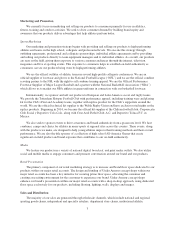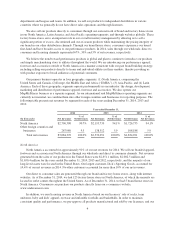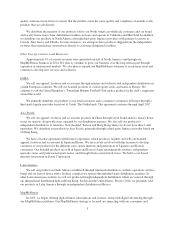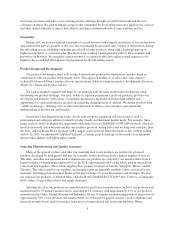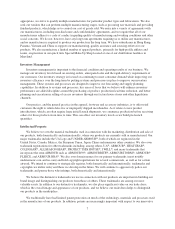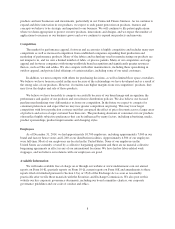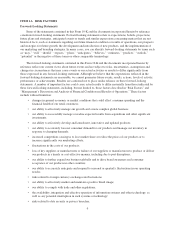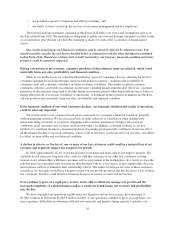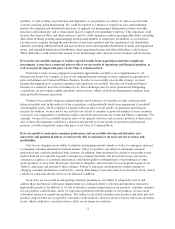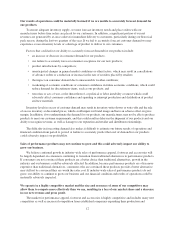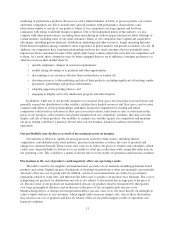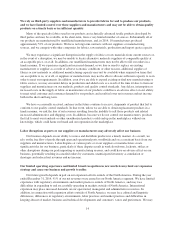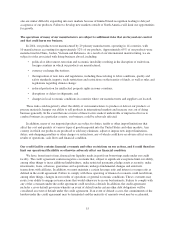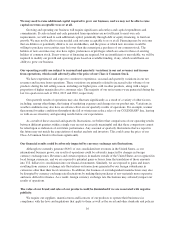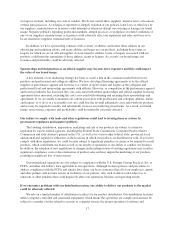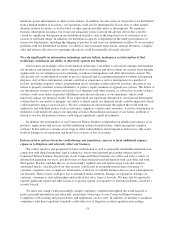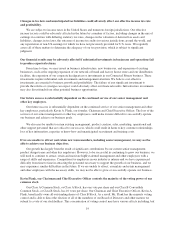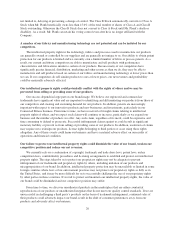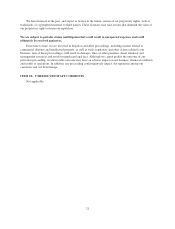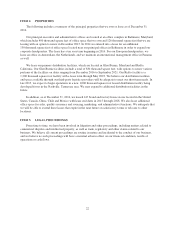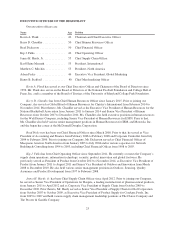Under Armour 2014 Annual Report Download - page 23
Download and view the complete annual report
Please find page 23 of the 2014 Under Armour annual report below. You can navigate through the pages in the report by either clicking on the pages listed below, or by using the keyword search tool below to find specific information within the annual report.marketing of performance products. Because we own a limited number of fabric or process patents, our curren
t
and future com
p
etitors are able to manufacture and sell
p
roducts with
p
erformance characteristics and
f
abrications similar to certain of our products. Many of our competitors are large apparel and footwear
companies with strong worldwide brand recognition. Due to the fragmented nature of the industry, we also
compete with other manufacturers, including those specializing in outdoor apparel and private label offerings of
certain retailers, including some of our retail customers. Many of our competitors have significant competitiv
e
advantages, including greater financial, distribution, marketing and other resources, longer operating histories,
better brand recognition among consumers, more experience in global markets and greater economies of scale. I
n
addition, our competitors have long term relationships with our key retail customers that are potentially more
important to those customers because of the significantly larger volume and product mix that our competitors sell
to them. As a result, these competitors may be better equipped than we are to influence consumer preferences o
r
o
therwise increase their market share by
:
•
quickly adapting to changes in customer requirements;
•
readily taking advantage of acquisition and other opportunities;
•
discounting excess inventory that has been written down or written off;
•
devoting resources to the marketing and sale of their products, including significant advertising, medi
a
p
lacement,
p
artnershi
p
s and
p
roduct endorsement
;
•
adopting aggressive pricing policies; an
d
•
engaging in lengthy and costly intellectual property and other disputes.
I
n addition, while one of our growth strategies is to increase floor space for our products in retail stores and
generally expand our distribution to other retailers, retailers have limited resources and floor space, and we must
compete with others to develop relationships with them. Increased competition by existing and future
com
p
etitors could result in reductions in floor s
p
ace in retail locations, reductions in sales or reductions in the
p
rices of our products, and if retailers earn greater margins from our competitors’ products, they may favor th
e
display and sale of those products. Our inability to compete successfully against our competitors and maintai
n
o
ur gross margin could have a material adverse effect on our business, financial condition and results o
f
op
erations.
O
ur pro
fi
tab
i
l
i
ty may decl
i
ne as a result o
fi
ncreas
i
ng pressure on marg
i
ns.
Our industry is subject to significant pricing pressure caused by many factors, including intens
e
competition, consolidation in the retail industry, pressure from retailers to reduce the costs of products and
changes in consumer demand. These factors may cause us to reduce our prices to retailers and consumers, whic
h
could cause our profitability to decline if we are unable to offset price reductions with comparable reductions i
n
o
ur operating costs. This could have a material adverse effect on our results of operations and financial condition
.
Fluctuat
i
ons
i
n the cost o
f
products could negat
i
vely a
ff
ect our operat
i
ng results
.
The fabrics used by our suppliers and manufacturers are made of raw materials including petroleum-base
d
p
roducts and cotton. Significant price fluctuations or shortages in petroleum or other raw materials can materially
adversely affect our cost of goods sold. In addition, certain of our manufacturers are subject to government
r
egulations related to wage rates, and therefore the labor costs to produce our products may fluctuate. The cost o
f
transporting our products for distribution and sale is also subject to fluctuation due in large part to the price o
f
o
il. Because most of our products are manufactured abroad, our products must be transported by third parties
o
ver large geographical distances and an increase in the price of oil can significantly increase costs.
Manufacturing delays or unexpected transportation delays can also cause us to rely more heavily on airfreight to
achieve timely delivery to our customers, which significantly increases freight costs. Any of these fluctuations
may increase our cost of products and have an adverse effect on our profit margins, results of operations and
f
inancial condition.
13


